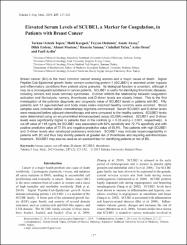| dc.contributor.author | Topçu, Türkan Öztürk | |
| dc.contributor.author | Kavgacı, Halil | |
| dc.contributor.author | Özdemir, Feyyaz | |
| dc.contributor.author | Aksoy, Asude | |
| dc.contributor.author | Erdem, Dilek | |
| dc.contributor.author | Mentesşe, Ahmet | |
| dc.contributor.author | Yaman, Hüseyin | |
| dc.contributor.author | Tufan, Gülnihal | |
| dc.contributor.author | Örem, Asım | |
| dc.contributor.author | Aydın, Fazıl | |
| dc.date.accessioned | 2020-12-19T19:56:34Z | |
| dc.date.available | 2020-12-19T19:56:34Z | |
| dc.date.issued | 2015 | |
| dc.identifier.citation | Topcu, T.O., Kavgaci, H., Ozdemir, F., Aksoy, A., Erdem, D., Mentese, A., Yaman, H. ve diğerleri (2015). Elevated serum levels of SCUBE1, a marker for coagulation, in patients with breast cancer. Tohoku Journal of Experimental Medicine, 237(2), 127-132. https://doi.org/10.1620/tjem.237.127 | en_US |
| dc.identifier.issn | 0040-8727 | |
| dc.identifier.issn | 1349-3329 | |
| dc.identifier.uri | https://doi.org/10.1620/tjem.237.127 | |
| dc.identifier.uri | https://hdl.handle.net/11436/2751 | |
| dc.description | aksoy, asude/0000-0002-5609-9658 | en_US |
| dc.description | WOS: 000364501100007 | en_US |
| dc.description | PubMed: 26438214 | en_US |
| dc.description.abstract | Breast cancer (BC) is the most common cancer among women and a major cause of death. Signal Peptide-Cub-Epidermal growth factor domain-containing protein-1 (SCUBE1) is secreted under hypoxia and inflammatory conditions from platelet alpha granules. Its biological function is uncertain, although it may be a procoagulant substance in cancer patients. SCUBE1 is useful for identifying thrombotic diseases, including cancers and acute coronary syndromes. D-dimer reflects the relationship between coagulation activation and fibrinolysis; namely, thrombosis and D-dinner levels are closely linked. This is the first investigation of the potential diagnostic and prognostic value of SCUBE1 levels in patients with BC. Fifty patients and 33 age-matched and body mass index-matched healthy controls were enrolled. Blood samples were collected before chemotherapy regimens commenced. Serum SCUBE1 and D-dimer levels were measured before adjuvant chemotherapy and were compared to the healthy controls. SCUBE1 levels were determined using an enzyme-linked immunosorbent assay (ELISA) method. SCUBE1 and D-dimer levels were significantly higher in patients than in the controls (p = 0.03 and p < 0.001, respectively). A cut-off value of 1.55 ng/mL for SCUBE1 was associated with 62% sensitivity and 72.7% specificity and with positive predictive value of 77.5% and negative predictive value of 55.8%. Two patients with high SCUBE1 and D-dimer levels also developed pulmonary embolism. SCUBE1 may indicate hypercoagulability in patients with BC and thus help identify patients at greater risk of thrombosis and requiring anti-thrombosis treatment. SCUBE1 may also be used as an assistant test for identifying patients at risk of BC. | en_US |
| dc.language.iso | eng | en_US |
| dc.publisher | Tohoku Univ Medical Press | en_US |
| dc.rights | info:eu-repo/semantics/openAccess | en_US |
| dc.subject | Breast cancer | en_US |
| dc.subject | Cut-off valu | en_US |
| dc.subject | D-dimer | en_US |
| dc.subject | SCUBE1 | en_US |
| dc.subject | Thrombosis | en_US |
| dc.title | Elevated serum levels of SCUBE1, a marker for coagulation, in patients with breast cancer | en_US |
| dc.type | article | en_US |
| dc.contributor.department | RTEÜ, Tıp Fakültesi, Dahili Tıp Bilimleri Bölümü | en_US |
| dc.contributor.institutionauthor | Tufan, Gülnihal | |
| dc.identifier.doi | 10.1620/tjem.237.127 | |
| dc.identifier.volume | 237 | en_US |
| dc.identifier.issue | 2 | en_US |
| dc.identifier.startpage | 127 | en_US |
| dc.identifier.endpage | 132 | en_US |
| dc.ri.edit | oa | en_US |
| dc.relation.journal | Tohoku Journal of Experimental Medicine | en_US |
| dc.relation.publicationcategory | Makale - Uluslararası Hakemli Dergi - Kurum Öğretim Elemanı | en_US |


















